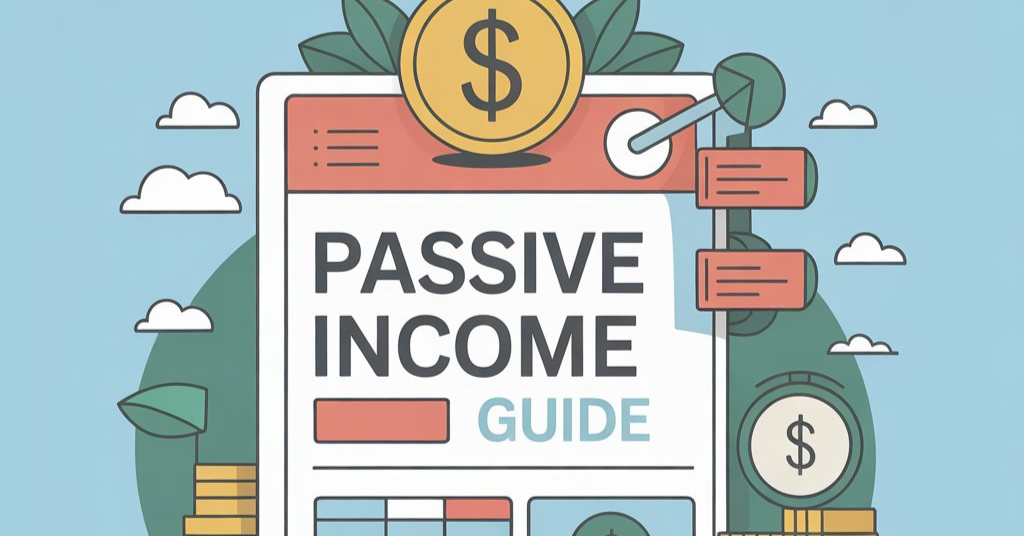Financial freedom is a dream for many people in the United States. With rising inflation, unstable job markets, and increasing living costs, depending only on a 9-to-5 paycheck feels risky. This is where passive income comes into play. Passive income refers to money you earn without constantly trading your time for it. With careful financial planning, it can provide stability, reduce stress, and help you reach goals like retirement, travel, or building wealth.
This passive income guide financial planning strategies will help you understand:
- What passive income is.
- Why it’s essential for long-term security.
- How to create streams of passive income.
- Examples and calculations to estimate real earnings.
- Risks, tax rules, and how to get started.
What is Passive Income?
The IRS defines passive income mainly as:
- Rental income from property.
- Business activities in which you don’t materially participate.
In simpler terms, it means earning money with little day-to-day involvement after the initial setup.
Passive vs. Active Income
- Active Income: A salary, hourly wages, or freelance projects where you directly trade time for money.
- Passive Income: Earnings from assets like rental property, dividend stocks, or digital products that keep generating cash even while you sleep.
Why Include Passive Income in Financial Planning?
Passive income isn’t about “getting rich overnight.” Instead, it supports your financial plan in several important ways:
- Diversification of Income: Multiple income streams protect you in case of job loss or business slowdown.
- Wealth Building: When reinvested, passive income compounds over time.
- Retirement Security: Passive income supplements Social Security, 401(k), or IRA savings.
- Inflation Hedge: Assets like real estate or dividend-growing stocks can rise with inflation.
- Lifestyle Flexibility: More income means more choices — working less, traveling, or early retirement.
Steps: Passive Income Guide Financial Planning
To successfully add passive income into your financial plan, follow these steps:
| Step | Action | Why It Matters |
| 1. Set Goals | Decide how much extra income you need monthly or yearly. | Clarity ensures realistic planning. |
| 2. Assess Resources | Evaluate savings, skills, time, and risk tolerance. | Each income stream needs different resources. |
| 3. Choose Options | Pick income streams that fit your budget and interests. | Better alignment = higher chance of success. |
| 4. Estimate Returns | Use calculations to project income potential. | Helps avoid unrealistic expectations. |
| 5. Plan Taxes | Learn about dividend tax, rental rules, or LLC benefits. | Saves money long term. |
| 6. Start Small | Test one or two streams first. | Mistakes are cheaper at smaller scale. |
| 7. Scale Gradually | Reinvest and grow income sources. | Builds strong long-term stability. |
Passive Income Ideas with Examples and Calculations
Let’s explore popular passive income sources with U.S.-based examples and simple calculations.
Also Check: 5 Ways How to Generate Passive Income in Australia
1. Dividend-Paying Stocks & ETFs
When you invest in dividend stocks or ETFs, companies share part of their profits with you.
Example Calculation:
- Investment = $50,000
- Average dividend yield = 4% annually
- Annual Income = $50,000 × 0.04 = $2,000/year
- Monthly Income = ~$167
Pros: Scalable, easy via brokerage apps, relatively hands-off.
Cons: Market risk, dividends can be reduced during downturns.
2. Rental Real Estate
Owning rental property can generate steady monthly income.
Example Calculation:
- Duplex price: $300,000
- Down payment: $60,000
- Mortgage + tax + insurance = $1,800/month
- Rent collected = $2,500/month
- Net cash flow = $2,500 – $1,800 = $700/month or $8,400/year
Pros: Rent often rises with inflation, property may appreciate.
Cons: Requires capital, maintenance, and dealing with tenants.
3. Real Estate Investment Trusts (REITs)
For those who don’t want to manage tenants, REITs are stocks that own real estate and pay dividends.
Example Calculation:
- Investment = $30,000
- Yield = 5%
- Annual Income = $30,000 × 0.05 = $1,500/year
Pros: Easy to buy/sell, no landlord headaches.
Cons: Sensitive to interest rates and property market trends.
4. High-Yield Savings Accounts, CDs, and Bonds
Safe but lower-yield options.
Example Calculation:
- Savings = $20,000
- Interest Rate = 3.5%
- Annual Interest = $700
Pros: Very low risk, FDIC insured.
Cons: Returns may not beat inflation.
5. Digital Products (E-Books, Courses, Templates)
Create once, sell repeatedly.
Example Calculation:
- Online course price = $100
- Sales = 100 per year
- Gross = $10,000
- After platform fees (30%) = $7,000 net
Pros: Scalable, can grow with marketing.
Cons: Requires initial effort, competition is high.
6. Peer-to-Peer Lending
Platforms like Prosper or LendingClub let you lend money to borrowers.
Example Calculation:
- Investment = $5,000
- Average interest = 8%
- Expected income = $400/year
- After defaults (2%) = ~$350 net
Pros: Higher return than savings.
Cons: Default risk, limited liquidity.
7. Renting Spare Assets
Spare rooms, cars, or even parking spaces can bring income.
Example Calculation (Airbnb):
- Rate = $75/night
- Occupancy = 15 nights/month
- Gross = $1,125/month
- After expenses (30%) = ~$787/month (~$9,444/year)
Combining Income Streams – Example Plan
Case Study: Jane’s Financial Plan
Jane wants $2,000/month in passive income within 5 years.
| Source | Investment | Annual Income |
| Dividend ETFs | $150,000 invested | $6,000/year |
| Rental Property | $60,000 down | $8,400/year |
| Online Course | $1,000 setup + time | $9,000/year |
| Airbnb Spare Room | Minimal setup | $9,400/year |
| Total | ~$211,000 + upfront work | ~$32,800/year (~$2,733/month) |
Jane surpasses her goal by combining different sources, balancing capital-intensive (real estate) and creative (digital).
Risks in Passive Income
- Capital Requirement: Many streams need upfront investment.
- Maintenance: Rentals need repairs, digital products need updates.
- Market Risks: Stocks fluctuate, platforms can shut down.
- Liquidity: Real estate isn’t quick to sell.
- Regulation: Airbnb restrictions, tax law changes.
Tax Planning for Passive Income
- Dividends: Qualified dividends taxed at lower capital gains rates.
- Rental Income: Deduct mortgage interest, taxes, repairs, depreciation.
- Digital Products: Consider LLC for legal protection and tax planning.
- Losses: Passive activity losses may be limited by IRS rules.
Example Calculation – Hitting $1,500/Month in 5 Years
Goal: $18,000/year passive income.
Plan: $50,000 annual investments split into dividend ETFs (60%) and real estate (40%).
By Year 5:
- ETFs: $150,000 at 4% = $6,000/year
- Rental properties: $100,000 in down payments = ~$12,000/year net
- Total = $18,000/year = $1,500/month
Getting Started Checklist
- Define your goal (e.g., $1,000/month).
- Pick 1–2 strategies (dividends, Airbnb, course creation).
- Estimate ROI with realistic calculations.
- Open required accounts (brokerage, REIT platform, Airbnb host).
- Start small and test.
- Reinvest income to grow faster.
- Monitor annually and adjust strategies.
Conclusion
Passive income is one of the most effective ways to build wealth and achieve financial security. It requires upfront effort, smart planning, and patience, but the long-term rewards are worth it. Whether through dividends, real estate, or digital products, adding passive income streams can strengthen your financial plan and give you more freedom.
Start small, stay consistent, and diversify your sources. With time, you’ll not only supplement your income but also move closer to financial independence.



